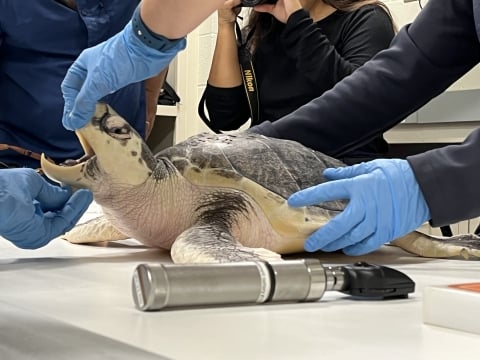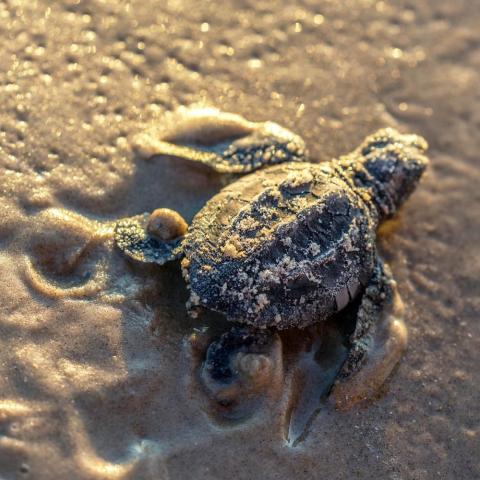With the help of Rotterdam Zoo curator Mark de Boer, Boeier will be diving back into her native waters from a Galveston beach lined with supporters, including members of the public and the organizations that helped arrange her long journey home, on Nov. 4, 2024.
“We are so happy that Boeier was rescued, rehabilitated and deemed healthy enough to release so that she can rejoin the reproductive population and potentially contribute to the recovery of the species,” said Mary Kay Skoruppa, the Service’s Sea Turtle Coordinator for Texas. “An added benefit is the opportunity to increase the Service’s and NOAA Fisheries’ knowledge about survival and movements of juvenile Kemp’s ridley sea turtles that strand in areas far outside of their normal migration routes.”
Kemp’s ridley sea turtles are the smallest and one of the most endangered species of sea turtles in the world. Primarily found in the Gulf of Mexico and in coastal waters of the Atlantic along eastern North America, the juvenile turtles are occasionally carried across the Atlantic by the powerful Gulf Stream.
While Boeier’s journey is a little unusual, she isn’t the only sub-tropical sea turtle or even the only Kemp’s ridley to be found stranded in European waters last year.
Around the same time as Boeier, the Rotterdam Zoo took in seven cold-stunned loggerhead sea turtles and one other Kemp’s ridley named Blof who had been found on Dutch beaches. The Anglesey Sea Zoo in North Wales has also taken in two stranded Kemp’s ridleys, including one named “Tally” that was released by partners from Galveston into the Gulf of Mexico last year.
This increase in Kemp’s ridley sea turtle strandings isn’t just an issue across the pond. In recent years, researchers have found an increasing number of cold-stunned sea turtles in New England, where they are seasonal residents in summer and early fall. Due to the hook shape of Cape Cod, instead of migrating south for the winter the juveniles are becoming trapped within the bay in waters that are too cold for them.
According to Fish and Wildlife Biologist Cynthia Rubio with the Service’s Texas Coastal and Central Plains Ecological Services Field Office, Boeier may be an example of what can happen when the juveniles end up too far from home.
“We are starting to see more juvenile Kemp’s ridleys off the East Coast, and due to the warmer water is pulling them into the Atlantic,” Rubio said. “I would bet that Boeier is probably one of those juveniles that was trapped there and drifted across the Atlantic.”
According to NOAA Fisheries, the annual average of Massachusetts cold-stunned turtles in the last 5 years is 739, compared to 20 years ago when it was only 139. One reason for this increase is that the Gulf of Maine, including Cape Cod Bay, is warming faster than most other bodies of water in the world. These warm waters likely result in more sea turtles moving into the area, either following currents or prey.
As cold-stunning cases increase, more sea turtles need to be transported to rehabilitation facilities nationwide. These rescue efforts and eventual releases involve significant coordination and collaboration among hundreds of staff and volunteers from various organizations.




 Support Essential Coverage of Essential Places
Support Essential Coverage of Essential Places







Comments
Regarding U.S. Senate Bill S.2086 - Sea Turtle Rescue Assistance and Rehabilitation Act of 2023, 118th Congress (2023-2024)
Senate Bill S.2086 proposes $30,000,000 funding over 6 fiscal years for sea turtle rescue assistance and rehabilitation, but it does not include language requiring determination of whether the proposed sea turtle rescue assistance and rehabilitation will contribute significantly to recovery of sea turtle populations. Therefore, I suggest that language be added to S.2086 to require that organizations and individuals that receive funding be required to mark, tag, and fit rehabilitated sea turtles with animal-borne transmitters (for tracking by satellite) before they are released into the wild, so that they can be identified as having been rescued and rehabilitated in captivity and distinguished from other sea turtles that have not been rescued and rehabilitated. This would make it possible to determine the fates of rescued and rehabilitated sea turtles after their release into the wild, and whether they survive to maturity and reproduce, thus contributing to recovery of sea turtle populations.
If passed by the Senate, reconciled with the House version of this bill, and signed into law by the President without containing the kinds of language I mention, the fates of these sea turtles may never be known.
See:
"A Call for Evaluation of the Contribution Made by Rescue, Resuscitation, Rehabilitation, and Release Translocations to Kemp's Ridley Sea Turtle (Lepidochelys kempii) Population Recovery", Herpetological Conservation and Biology 11:486-496, Published: 16 December 2016 (https://www.herpconbio.org/Volume_11/Issue_3/Caillouet_etal_2016.pdf)